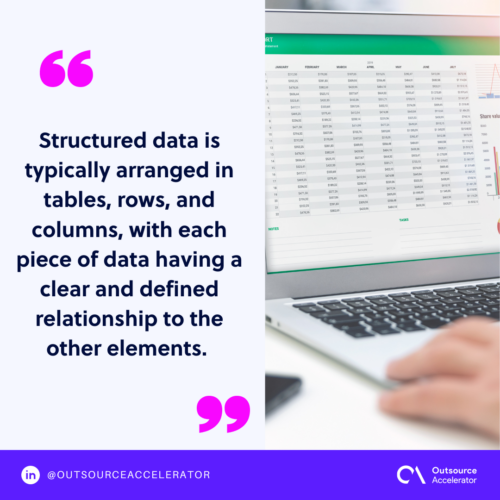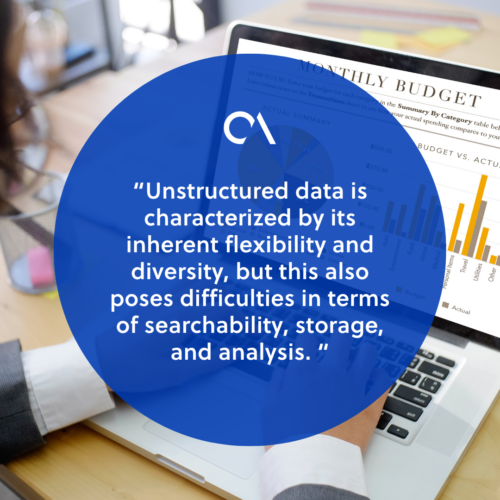Structured data vs. Unstructured data: What’s the difference?

The amount of information being produced in today’s digital world is staggering.
From customer transaction records to social media posts, data is being collected and stored at an unprecedented rate.
But not all data is created equal.
Some information is neatly organized and easily searchable, while other data exists in a more chaotic and unorganized form.
This article delves into the intricacies of structured data vs. unstructured data. We’ll explore their characteristics, advantages, and the impact they have on business.
Structured data vs. Unstructured data: Definition of terms
Here’s a brief overview of each term:
What is structured data?
Structured data is any data that is highly organized and formatted to be easily searchable in a computer system or database. This type of data appears in a highly predictable way, with a consistent pattern that makes it easy to store and access.
Structured data is typically arranged in tables, rows, and columns, with each piece of data having a clear and defined relationship to the other elements.

Because structured data is organized this way, it can be processed and analyzed by computers using algorithms. This makes it ideal for tasks that require large-scale data processing.
Structured data plays a crucial role in many industries, supporting activities such as data analysis, reporting, and the functioning of relational databases.
What is unstructured data?
On the other hand, unstructured data refers to information that lacks a predefined data model or organizational structure. Unlike structured data, unstructured data does not fit neatly into tables or rows and often lacks a consistent pattern.
Unstructured data can take various forms, such as:
- Text documents
- Images
- Videos
- Emails
- Social media posts
- Audio files
- Sensor data
Unstructured data is characterized by its inherent flexibility and diversity, but this also poses difficulties in terms of searchability, storage, and analysis.
Extracting it requires advanced techniques such as natural language processing, image recognition, and machine learning algorithms.
Despite these challenges, unstructured data holds immense worth as it often contains valuable insights, sentiments, and context. This information is used to understand consumer behavior and trends.

Structured data vs. Unstructured data: Similarities and differences
This section compares structured data vs. unstructured data in terms of their similarities and differences.
Similarities of structured and unstructured data
While structured data and unstructured data differ significantly in their organization and format, they share certain similarities in their purposes:
Business value
Both types of data can provide insights and information for businesses.
Structured data can provide quantitative and well-defined metrics, while unstructured data can offer qualitative insights, sentiments, and context.
Decision-making
Both types of data can be used to make informed decisions based on patterns and trends.
Structured data can inform business decisions related to sales, marketing, and finance. Unstructured data can inform decisions related to customer service and product development.
Analysis and processing
Both types of data can be subjected to analysis and processing, albeit with different methods. Modern data analytics tools are capable of handling both structured data and unstructured data.
Structured data is suitable for traditional relational database queries and structured query language (SQL) operations. Unstructured data may require specialized tools and techniques such as NLP for text analysis or OCR for images.
Overall, both data types play complementary roles in providing insights into business operations and customer behavior.
Differences between structured and unstructured data
When discussing structured data vs. unstructured data, you must note that they differ in several key aspects:
Organization
Structured data, as the name implies, is organized and fits neatly into specified formats with a predefined schema. These formats include databases, spreadsheets, or tables. It follows a clear structure with fields and relationships, making it easier to analyze.
On the opposite end, unstructured data lacks a predefined structure. It doesn’t fit into traditional tables or databases and is not organized predictably.
Format
Structured data is typically represented in a tabular format with clearly defined rows and columns. Each column represents a specific attribute, and each row is a distinct record or entry.
In contrast, unstructured data doesn’t adhere to a specific format or fixed layout. It may appear as free-form text, multimedia files, or any other data format that doesn’t follow a specific structure.
Flexibility
Structured data is rigid due to following an organized schema. Any changes to the structure require modifications to the schema.
Unstructured data is highly flexible and can accommodate various formats. Due to not adhering to a fixed schema, it allows for diverse and dynamic content.
Searchability and accessibility
Structured data is highly searchable and can be easily accessed using database management systems. It allows for easy retrieval and analysis of specific information based on predefined criteria.
Unstructured data is more challenging to search and analyze. Advanced techniques are needed to extract meaningful information and make it searchable.
Analysis complexity
Structured data is relatively easier to analyze. Common analysis methods include aggregations, calculations, and generating reports to gain insights.
Unstructured data needs more complex analysis methods. Techniques like sentiment analysis, image recognition, and text mining are employed to make sense of unstructured data.
Data types and examples
Structured data primarily consists of quantifiable and well-defined data, such as numerical values, dates, and categorical variables.
Examples include:
- Databases
- Spreadsheets
- Tables
- Datasets with a clear organization
Unstructured data contains qualitative and subjective information. It encompasses data like:
- Social media posts
- Customer reviews
- Email communications
Utilizing both structured and unstructured data
Rather than fixate on the differences between structured data vs. unstructured data, companies should recognize the value of utilizing both.

Companies should view these data types not as isolated entities but as complementary resources. By harnessing the strengths of both types, organizations can gain a holistic understanding of their operations, customers, and market.
The key lies in adopting flexible data architectures, implementing advanced analytics, and fostering a culture of innovation.
The businesses that succeed in this will be better positioned to adapt and thrive as more data permeates the world.







 Independent
Independent




